1998 OPEL FRONTERA bulb
[x] Cancel search: bulbPage 3502 of 6000
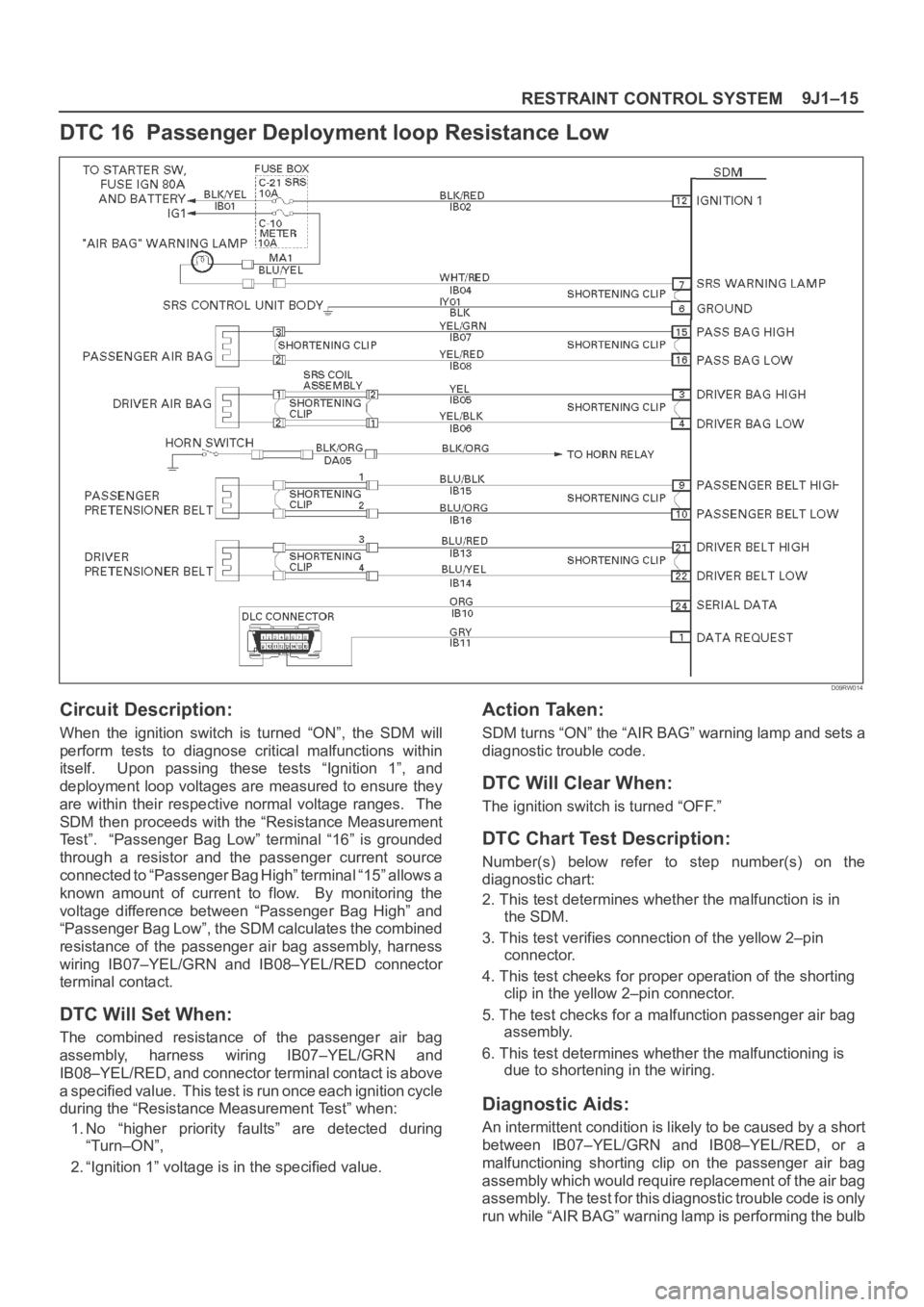
9J1–15
RESTRAINT CONTROL SYSTEM
DTC 16 Passenger Deployment loop Resistance Low
D09RW014
Circuit Description:
When the ignition switch is turned “ON”, the SDM will
perform tests to diagnose critical malfunctions within
itself. Upon passing these tests “Ignition 1”, and
deployment loop voltages are measured to ensure they
are within their respective normal voltage ranges. The
SDM then proceeds with the “Resistance Measurement
Test”. “Passenger Bag Low” terminal “16” is grounded
through a resistor and the passenger current source
connected to “Passenger Bag High” terminal “15” allows a
known amount of current to flow. By monitoring the
voltage difference between “Passenger Bag High” and
“Passenger Bag Low”, the SDM calculates the combined
resistance of the passenger air bag assembly, harness
wiring IB07–YEL/GRN and IB08–YEL/RED connector
terminal contact.
DTC Will Set When:
The combined resistance of the passenger air bag
assembly, harness wiring IB07–YEL/GRN and
IB08–YEL/RED, and connector terminal contact is above
a specified value. This test is run once each ignition cycle
during the “Resistance Measurement Test” when:
1. No “higher priority faults” are detected during
“Turn–ON”,
2. “Ignition 1” voltage is in the specified value.
Action Taken:
SDM turns “ON” the “AIR BAG” warning lamp and sets a
diagnostic trouble code.
DTC Will Clear When:
The ignition switch is turned “OFF.”
DTC Chart Test Description:
Number(s) below refer to step number(s) on the
diagnostic chart:
2. This test determines whether the malfunction is in
the SDM.
3. This test verifies connection of the yellow 2–pin
connector.
4. This test cheeks for proper operation of the shorting
clip in the yellow 2–pin connector.
5. The test checks for a malfunction passenger air bag
assembly.
6. This test determines whether the malfunctioning is
due to shortening in the wiring.
Diagnostic Aids:
An intermittent condition is likely to be caused by a short
between IB07–YEL/GRN and IB08–YEL/RED, or a
malfunctioning shorting clip on the passenger air bag
assembly which would require replacement of the air bag
assembly. The test for this diagnostic trouble code is only
run while “AIR BAG” warning lamp is performing the bulb
Page 3511 of 6000
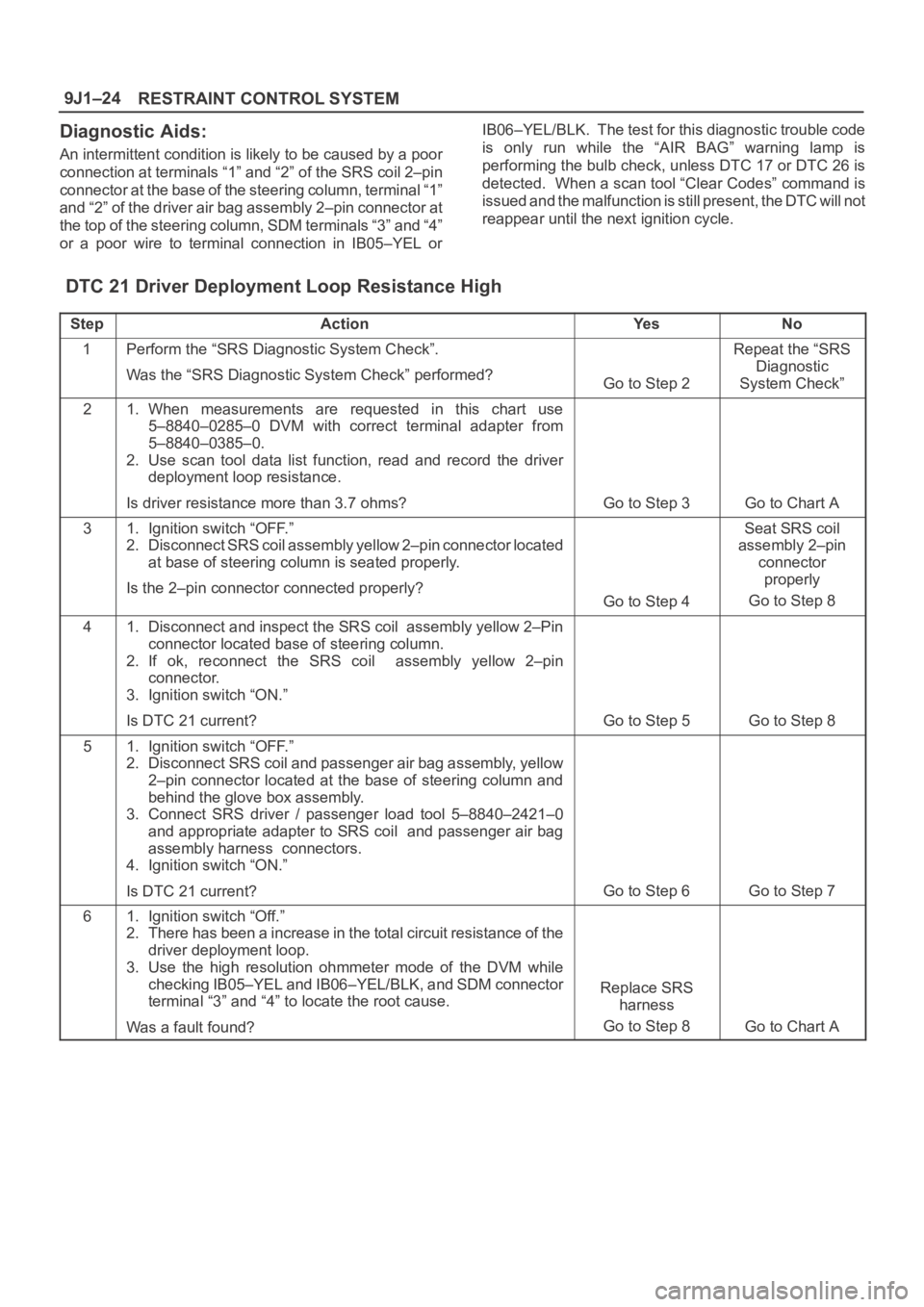
RESTRAINT CONTROL SYSTEM 9J1–24
Diagnostic Aids:
An intermittent condition is likely to be caused by a poor
connection at terminals “1” and “2” of the SRS coil 2–pin
connector at the base of the steering column, terminal “1”
and “2” of the driver air bag assembly 2–pin connector at
the top of the steering column, SDM terminals “3” and “4”
or a poor wire to terminal connection in IB05–YEL orIB06–YEL/BLK. The test for this diagnostic trouble code
is only run while the “AIR BAG” warning lamp is
performing the bulb check, unless DTC 17 or DTC 26 is
detected. When a scan tool “Clear Codes” command is
issued and the malfunction is still present, the DTC will not
reappear until the next ignition cycle.
DTC 21 Driver Deployment Loop Resistance High
StepActionYe sNo
1Perform the “SRS Diagnostic System Check”.
Was the “SRS Diagnostic System Check” performed?
Go to Step 2
Repeat the “SRS
Diagnostic
System Check”
21. When measurements are requested in this chart use
5–8840–0285–0 DVM with correct terminal adapter from
5–8840–0385–0.
2. Use scan tool data list function, read and record the driver
deployment loop resistance.
Is driver resistance more than 3.7 ohms?
Go to Step 3Go to Chart A
31. Ignition switch “OFF.”
2. Disconnect SRS coil assembly yellow 2–pin connector located
at base of steering column is seated properly.
Is the 2–pin connector connected properly?
Go to Step 4
Seat SRS coil
assembly 2–pin
connector
properly
Go to Step 8
41. Disconnect and inspect the SRS coil assembly yellow 2–Pin
connector located base of steering column.
2. If ok, reconnect the SRS coil assembly yellow 2–pin
connector.
3. Ignition switch “ON.”
Is DTC 21 current?
Go to Step 5Go to Step 8
51. Ignition switch “OFF.”
2. Disconnect SRS coil and passenger air bag assembly, yellow
2–pin connector located at the base of steering column and
behind the glove box assembly.
3. Connect SRS driver / passenger load tool 5–8840–2421–0
and appropriate adapter to SRS coil and passenger air bag
assembly harness connectors.
4. Ignition switch “ON.”
Is DTC 21 current?
Go to Step 6Go to Step 7
61. Ignition switch “Off.”
2. There has been a increase in the total circuit resistance of the
driver deployment loop.
3. Use the high resolution ohmmeter mode of the DVM while
checking IB05–YEL and IB06–YEL/BLK, and SDM connector
terminal “3” and “4” to locate the root cause.
Was a fault found?
Replace SRS
harness
Go to Step 8
Go to Chart A
Page 3514 of 6000
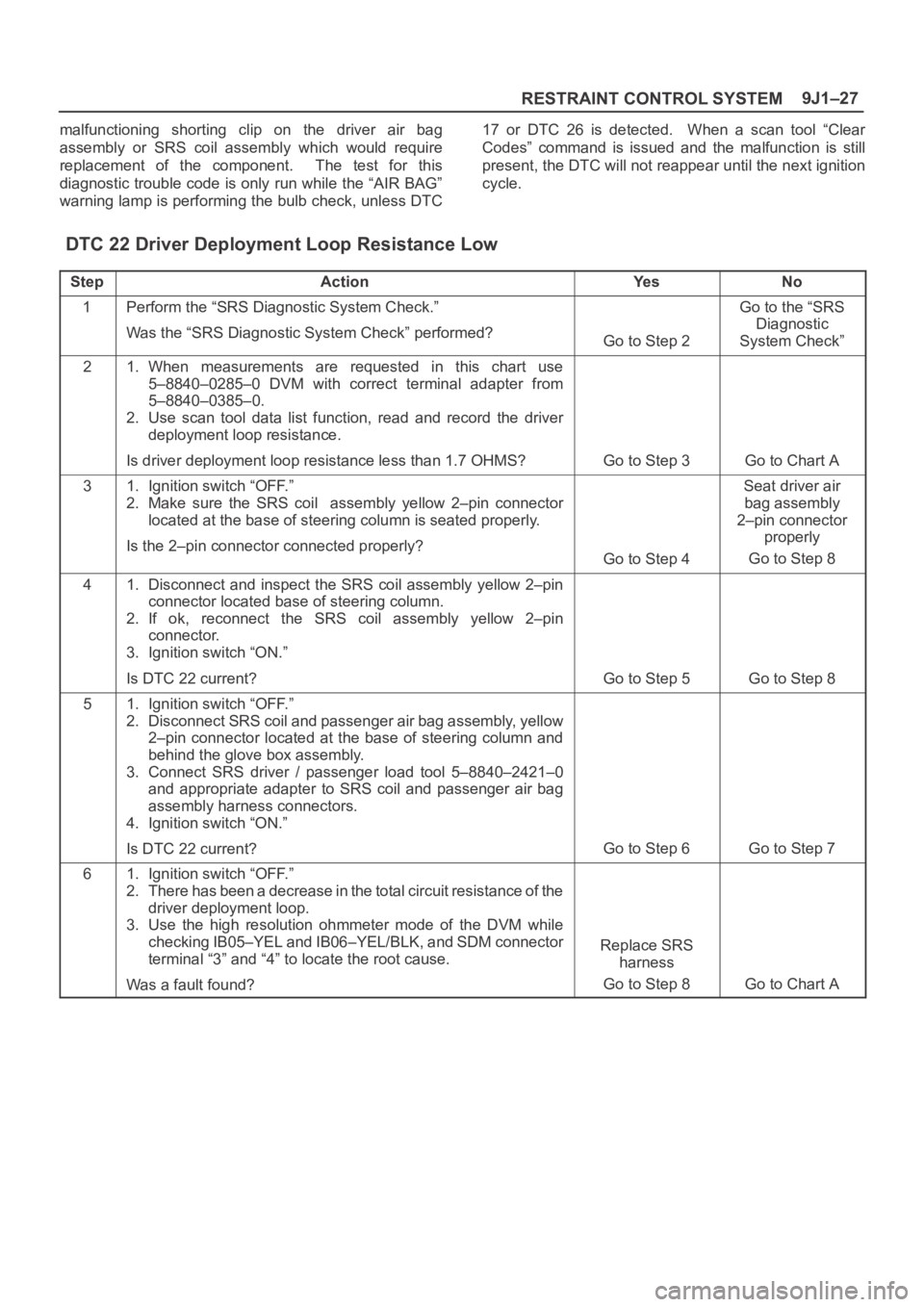
9J1–27
RESTRAINT CONTROL SYSTEM
malfunctioning shorting clip on the driver air bag
assembly or SRS coil assembly which would require
replacement of the component. The test for this
diagnostic trouble code is only run while the “AIR BAG”
warning lamp is performing the bulb check, unless DTC17 or DTC 26 is detected. When a scan tool “Clear
Codes” command is issued and the malfunction is still
present, the DTC will not reappear until the next ignition
cycle.
DTC 22 Driver Deployment Loop Resistance Low
StepActionYe sNo
1Perform the “SRS Diagnostic System Check.”
Was the “SRS Diagnostic System Check” performed?
Go to Step 2
Go to the “SRS
Diagnostic
System Check”
21. When measurements are requested in this chart use
5–8840–0285–0 DVM with correct terminal adapter from
5–8840–0385–0.
2. Use scan tool data list function, read and record the driver
deployment loop resistance.
Is driver deployment loop resistance less than 1.7 OHMS?
Go to Step 3Go to Chart A
31. Ignition switch “OFF.”
2. Make sure the SRS coil assembly yellow 2–pin connector
located at the base of steering column is seated properly.
Is the 2–pin connector connected properly?
Go to Step 4
Seat driver air
bag assembly
2–pin connector
properly
Go to Step 8
41. Disconnect and inspect the SRS coil assembly yellow 2–pin
connector located base of steering column.
2. If ok, reconnect the SRS coil assembly yellow 2–pin
connector.
3. Ignition switch “ON.”
Is DTC 22 current?
Go to Step 5Go to Step 8
51. Ignition switch “OFF.”
2. Disconnect SRS coil and passenger air bag assembly, yellow
2–pin connector located at the base of steering column and
behind the glove box assembly.
3. Connect SRS driver / passenger load tool 5–8840–2421–0
and appropriate adapter to SRS coil and passenger air bag
assembly harness connectors.
4. Ignition switch “ON.”
Is DTC 22 current?
Go to Step 6Go to Step 7
61. Ignition switch “OFF.”
2. There has been a decrease in the total circuit resistance of the
driver deployment loop.
3. Use the high resolution ohmmeter mode of the DVM while
checking IB05–YEL and IB06–YEL/BLK, and SDM connector
terminal “3” and “4” to locate the root cause.
Was a fault found?
Replace SRS
harness
Go to Step 8
Go to Chart A
Page 3533 of 6000
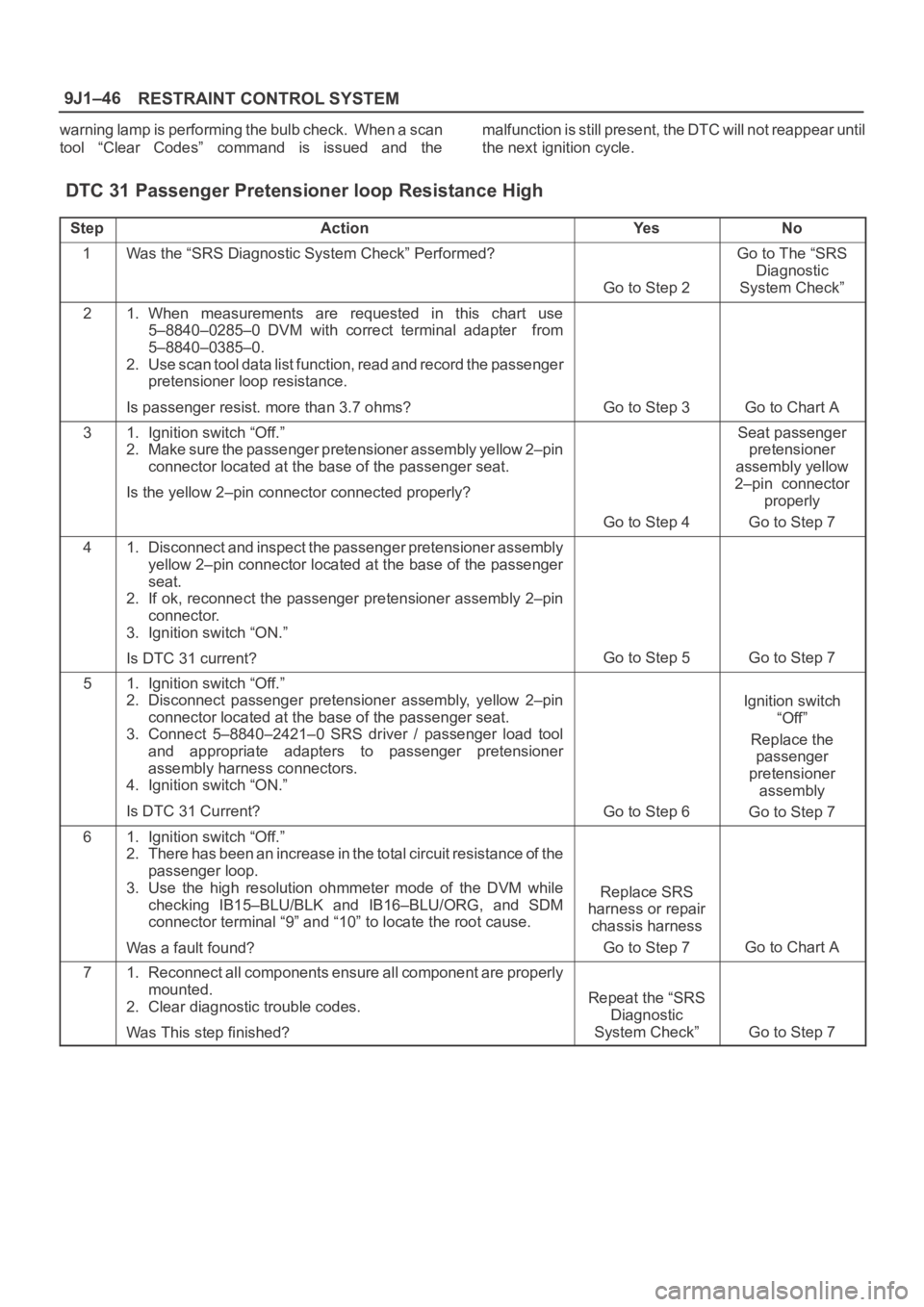
RESTRAINT CONTROL SYSTEM 9J1–46
warning lamp is performing the bulb check. When a scan
tool “Clear Codes” command is issued and themalfunction is still present, the DTC will not reappear until
the next ignition cycle.
DTC 31 Passenger Pretensioner loop Resistance High
StepActionYe sNo
1Was the “SRS Diagnostic System Check” Performed?
Go to Step 2
Go to The “SRS
Diagnostic
System Check”
21. When measurements are requested in this chart use
5–8840–0285–0 DVM with correct terminal adapter from
5–8840–0385–0.
2. Use scan tool data list function, read and record the passenger
pretensioner loop resistance.
Is passenger resist. more than 3.7 ohms?
Go to Step 3Go to Chart A
31. Ignition switch “Off.”
2. Make sure the passenger pretensioner assembly yellow 2–pin
connector located at the base of the passenger seat.
Is the yellow 2–pin connector connected properly?
Go to Step 4
Seat passenger
pretensioner
assembly yellow
2–pin connector
properly
Go to Step 7
41. Disconnect and inspect the passenger pretensioner assembly
yellow 2–pin connector located at the base of the passenger
seat.
2. If ok, reconnect the passenger pretensioner assembly 2–pin
connector.
3. Ignition switch “ON.”
Is DTC 31 current?
Go to Step 5Go to Step 7
51. Ignition switch “Off.”
2. Disconnect passenger pretensioner assembly, yellow 2–pin
connector located at the base of the passenger seat.
3. Connect 5–8840–2421–0 SRS driver / passenger load tool
and appropriate adapters to passenger pretensioner
assembly harness connectors.
4. Ignition switch “ON.”
Is DTC 31 Current?
Go to Step 6
Ignition switch
“Off”
Replace the
passenger
pretensioner
assembly
Go to Step 7
61. Ignition switch “Off.”
2. There has been an increase in the total circuit resistance of t h e
passenger loop.
3. Use the high resolution ohmmeter mode of the DVM while
checking IB15–BLU/BLK and IB16–BLU/ORG, and SDM
connector terminal “9” and “10” to locate the root cause.
Was a fault found?
Replace SRS
harness or repair
chassis harness
Go to Step 7
Go to Chart A
71. Reconnect all components ensure all component are properly
mounted.
2. Clear diagnostic trouble codes.
Was This step finished?
Repeat the “SRS
Diagnostic
System Check”
Go to Step 7
Page 3535 of 6000
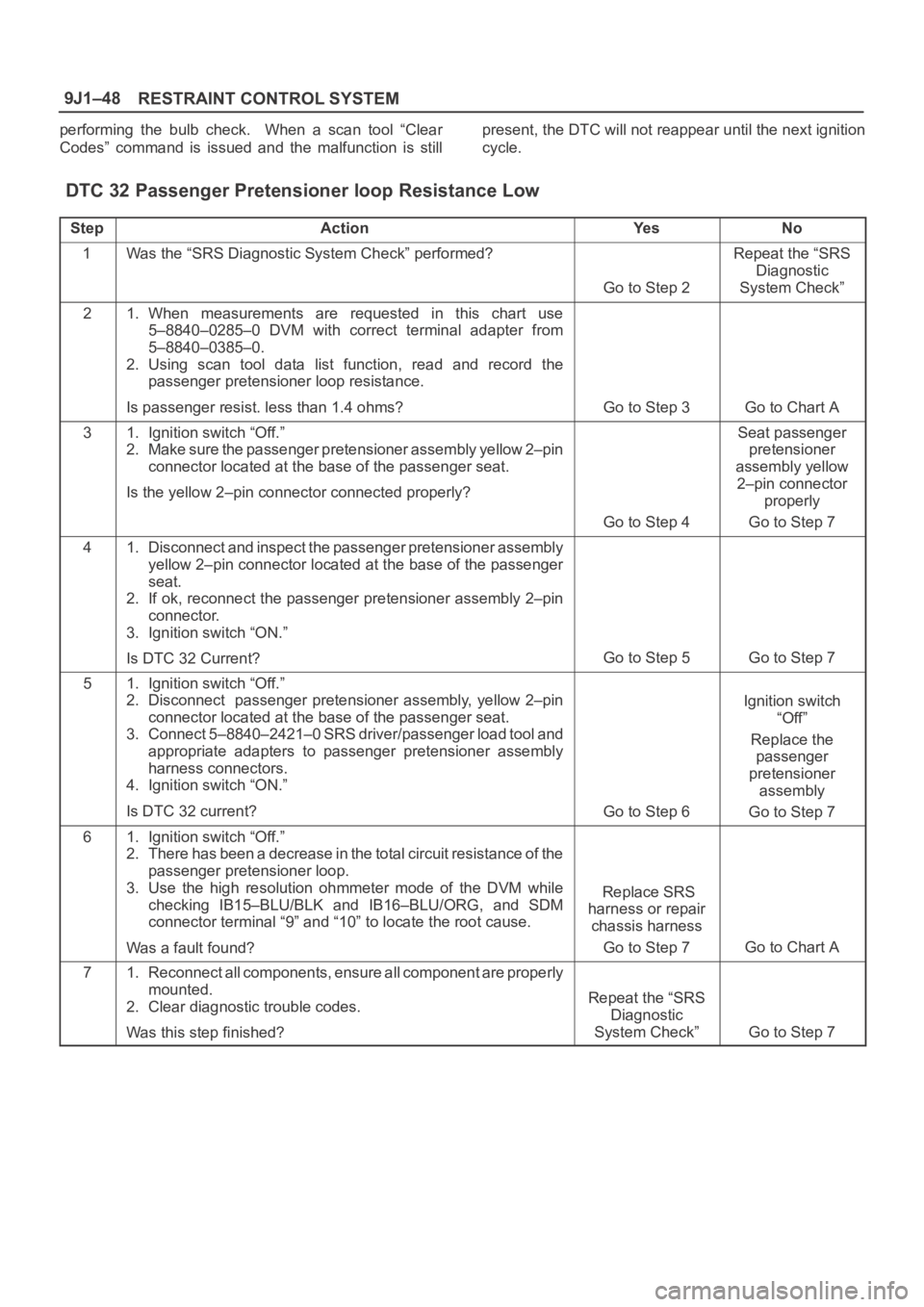
RESTRAINT CONTROL SYSTEM 9J1–48
performing the bulb check. When a scan tool “Clear
Codes” command is issued and the malfunction is stillpresent, the DTC will not reappear until the next ignition
cycle.
DTC 32 Passenger Pretensioner loop Resistance Low
StepActionYe sNo
1Was the “SRS Diagnostic System Check” performed?
Go to Step 2
Repeat the “SRS
Diagnostic
System Check”
21. When measurements are requested in this chart use
5–8840–0285–0 DVM with correct terminal adapter from
5–8840–0385–0.
2. Using scan tool data list function, read and record the
passenger pretensioner loop resistance.
Is passenger resist. less than 1.4 ohms?
Go to Step 3Go to Chart A
31. Ignition switch “Off.”
2. Make sure the passenger pretensioner assembly yellow 2–pin
connector located at the base of the passenger seat.
Is the yellow 2–pin connector connected properly?
Go to Step 4
Seat passenger
pretensioner
assembly yellow
2–pin connector
properly
Go to Step 7
41. Disconnect and inspect the passenger pretensioner assembly
yellow 2–pin connector located at the base of the passenger
seat.
2. If ok, reconnect the passenger pretensioner assembly 2–pin
connector.
3. Ignition switch “ON.”
Is DTC 32 Current?
Go to Step 5Go to Step 7
51. Ignition switch “Off.”
2. Disconnect passenger pretensioner assembly, yellow 2–pin
connector located at the base of the passenger seat.
3. Connect 5–8840–2421–0 SRS driver/passenger load tool and
appropriate adapters to passenger pretensioner assembly
harness connectors.
4. Ignition switch “ON.”
Is DTC 32 current?
Go to Step 6
Ignition switch
“Off”
Replace the
passenger
pretensioner
assembly
Go to Step 7
61. Ignition switch “Off.”
2. There has been a decrease in the total circuit resistance of the
passenger pretensioner loop.
3. Use the high resolution ohmmeter mode of the DVM while
checking IB15–BLU/BLK and IB16–BLU/ORG, and SDM
connector terminal “9” and “10” to locate the root cause.
Was a fault found?
Replace SRS
harness or repair
chassis harness
Go to Step 7
Go to Chart A
71. Reconnect all components, ensure all component are properly
mounted.
2. Clear diagnostic trouble codes.
Was this step finished?
Repeat the “SRS
Diagnostic
System Check”
Go to Step 7
Page 3541 of 6000
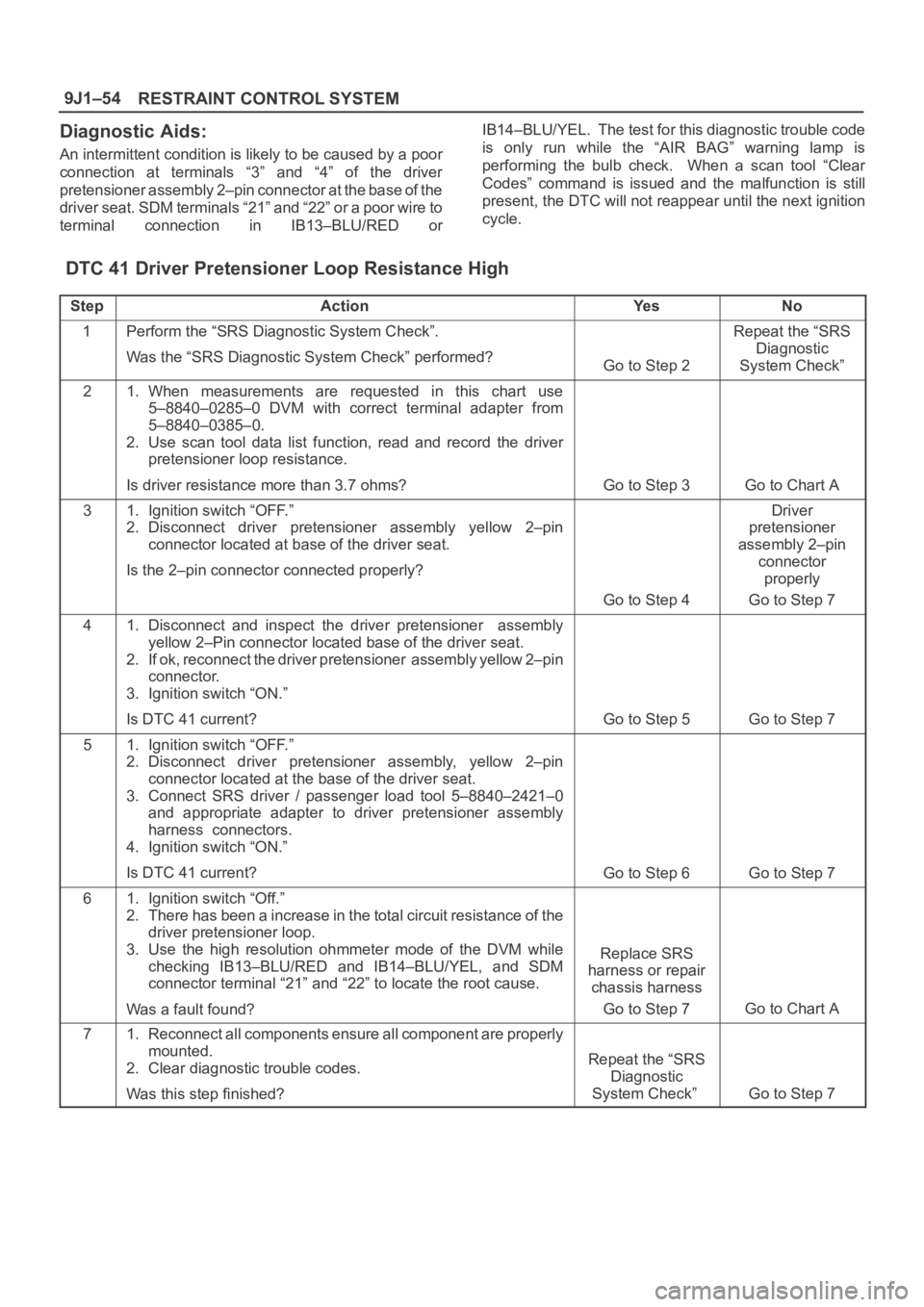
RESTRAINT CONTROL SYSTEM 9J1–54
Diagnostic Aids:
An intermittent condition is likely to be caused by a poor
connection at terminals “3” and “4” of the driver
pretensioner assembly 2–pin connector at the base of the
driver seat. SDM terminals “21” and “22” or a poor wire to
terminal connection in IB13–BLU/RED orIB14–BLU/YEL. The test for this diagnostic trouble code
is only run while the “AIR BAG” warning lamp is
performing the bulb check. When a scan tool “Clear
Codes” command is issued and the malfunction is still
present, the DTC will not reappear until the next ignition
cycle.
DTC 41 Driver Pretensioner Loop Resistance High
StepActionYe sNo
1Perform the “SRS Diagnostic System Check”.
Was the “SRS Diagnostic System Check” performed?
Go to Step 2
Repeat the “SRS
Diagnostic
System Check”
21. When measurements are requested in this chart use
5–8840–0285–0 DVM with correct terminal adapter from
5–8840–0385–0.
2. Use scan tool data list function, read and record the driver
pretensioner loop resistance.
Is driver resistance more than 3.7 ohms?
Go to Step 3Go to Chart A
31. Ignition switch “OFF.”
2. Disconnect driver pretensioner assembly yellow 2–pin
connector located at base of the driver seat.
Is the 2–pin connector connected properly?
Go to Step 4
Driver
pretensioner
assembly 2–pin
connector
properly
Go to Step 7
41. Disconnect and inspect the driver pretensioner assembly
yellow 2–Pin connector located base of the driver seat.
2. If ok, reconnect the driver pretensioner assembly yellow 2–pin
connector.
3. Ignition switch “ON.”
Is DTC 41 current?
Go to Step 5Go to Step 7
51. Ignition switch “OFF.”
2. Disconnect driver pretensioner assembly, yellow 2–pin
connector located at the base of the driver seat.
3. Connect SRS driver / passenger load tool 5–8840–2421–0
and appropriate adapter to driver pretensioner assembly
harness connectors.
4. Ignition switch “ON.”
Is DTC 41 current?
Go to Step 6Go to Step 7
61. Ignition switch “Off.”
2. There has been a increase in the total circuit resistance of the
driver pretensioner loop.
3. Use the high resolution ohmmeter mode of the DVM while
checking IB13–BLU/RED and IB14–BLU/YEL, and SDM
connector terminal “21” and “22” to locate the root cause.
Was a fault found?
Replace SRS
harness or repair
chassis harness
Go to Step 7
Go to Chart A
71. Reconnect all components ensure all component are properly
mounted.
2. Clear diagnostic trouble codes.
Was this step finished?
Repeat the “SRS
Diagnostic
System Check”
Go to Step 7
Page 3543 of 6000
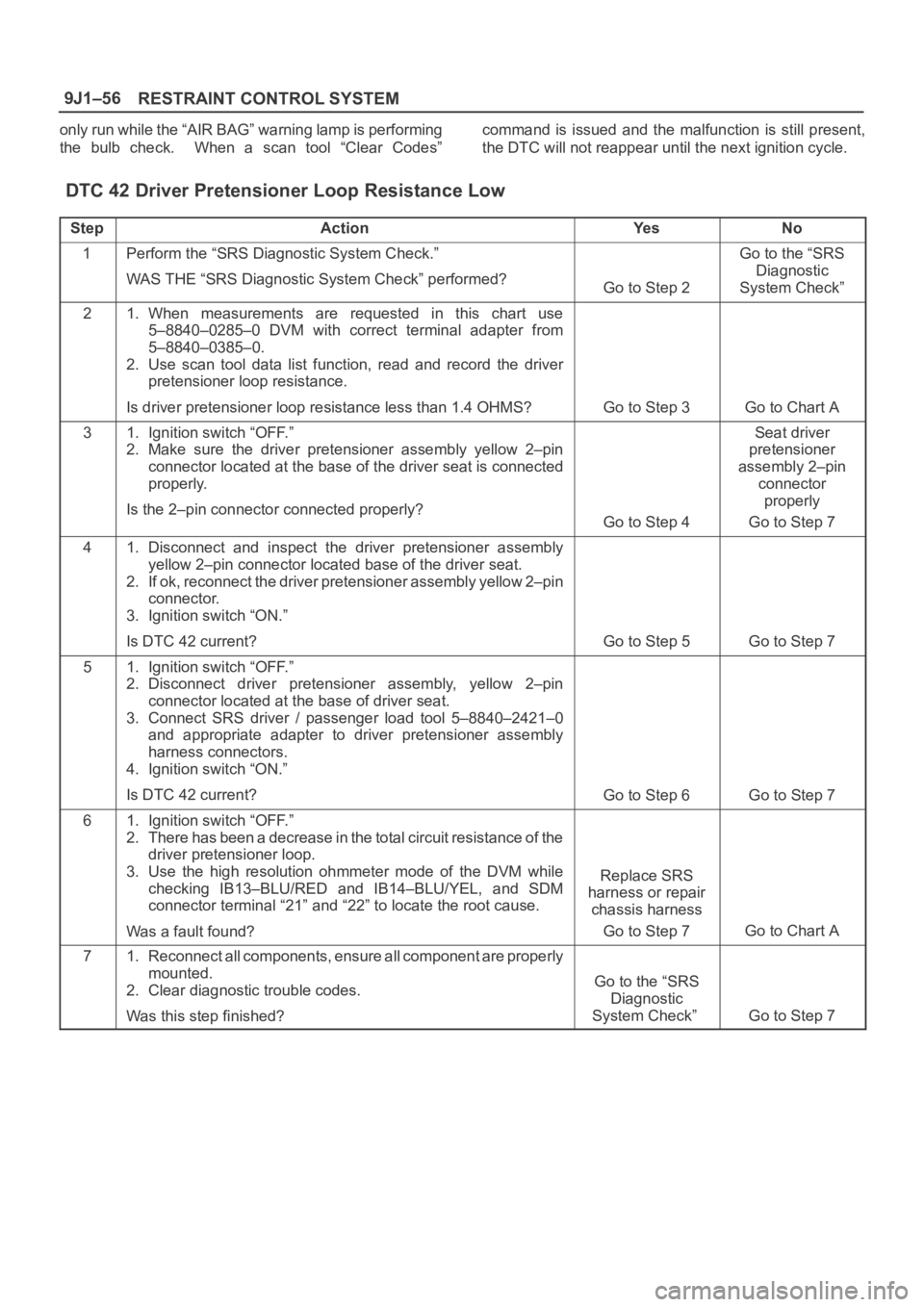
RESTRAINT CONTROL SYSTEM 9J1–56
only run while the “AIR BAG” warning lamp is performing
the bulb check. When a scan tool “Clear Codes”command is issued and the malfunction is still present,
the DTC will not reappear until the next ignition cycle.
DTC 42 Driver Pretensioner Loop Resistance Low
StepActionYe sNo
1Perform the “SRS Diagnostic System Check.”
WAS THE “SRS Diagnostic System Check” performed?
Go to Step 2
Go to the “SRS
Diagnostic
System Check”
21. When measurements are requested in this chart use
5–8840–0285–0 DVM with correct terminal adapter from
5–8840–0385–0.
2. Use scan tool data list function, read and record the driver
pretensioner loop resistance.
Is driver pretensioner loop resistance less than 1.4 OHMS?
Go to Step 3Go to Chart A
31. Ignition switch “OFF.”
2. Make sure the driver pretensioner assembly yellow 2–pin
connector located at the base of the driver seat is connected
properly.
Is the 2–pin connector connected properly?
Go to Step 4
Seat driver
pretensioner
assembly 2–pin
connector
properly
Go to Step 7
41. Disconnect and inspect the driver pretensioner assembly
yellow 2–pin connector located base of the driver seat.
2. If ok, reconnect the driver pretensioner assembly yellow 2–pin
connector.
3. Ignition switch “ON.”
Is DTC 42 current?
Go to Step 5Go to Step 7
51. Ignition switch “OFF.”
2. Disconnect driver pretensioner assembly, yellow 2–pin
connector located at the base of driver seat.
3. Connect SRS driver / passenger load tool 5–8840–2421–0
and appropriate adapter to driver pretensioner assembly
harness connectors.
4. Ignition switch “ON.”
Is DTC 42 current?
Go to Step 6Go to Step 7
61. Ignition switch “OFF.”
2. There has been a decrease in the total circuit resistance of the
driver pretensioner loop.
3. Use the high resolution ohmmeter mode of the DVM while
checking IB13–BLU/RED and IB14–BLU/YEL, and SDM
connector terminal “21” and “22” to locate the root cause.
Was a fault found?
Replace SRS
harness or repair
chassis harness
Go to Step 7
Go to Chart A
71. Reconnect all components, ensure all component are properly
mounted.
2. Clear diagnostic trouble codes.
Was this step finished?
Go to the “SRS
Diagnostic
System Check”
Go to Step 7
Page 4056 of 6000
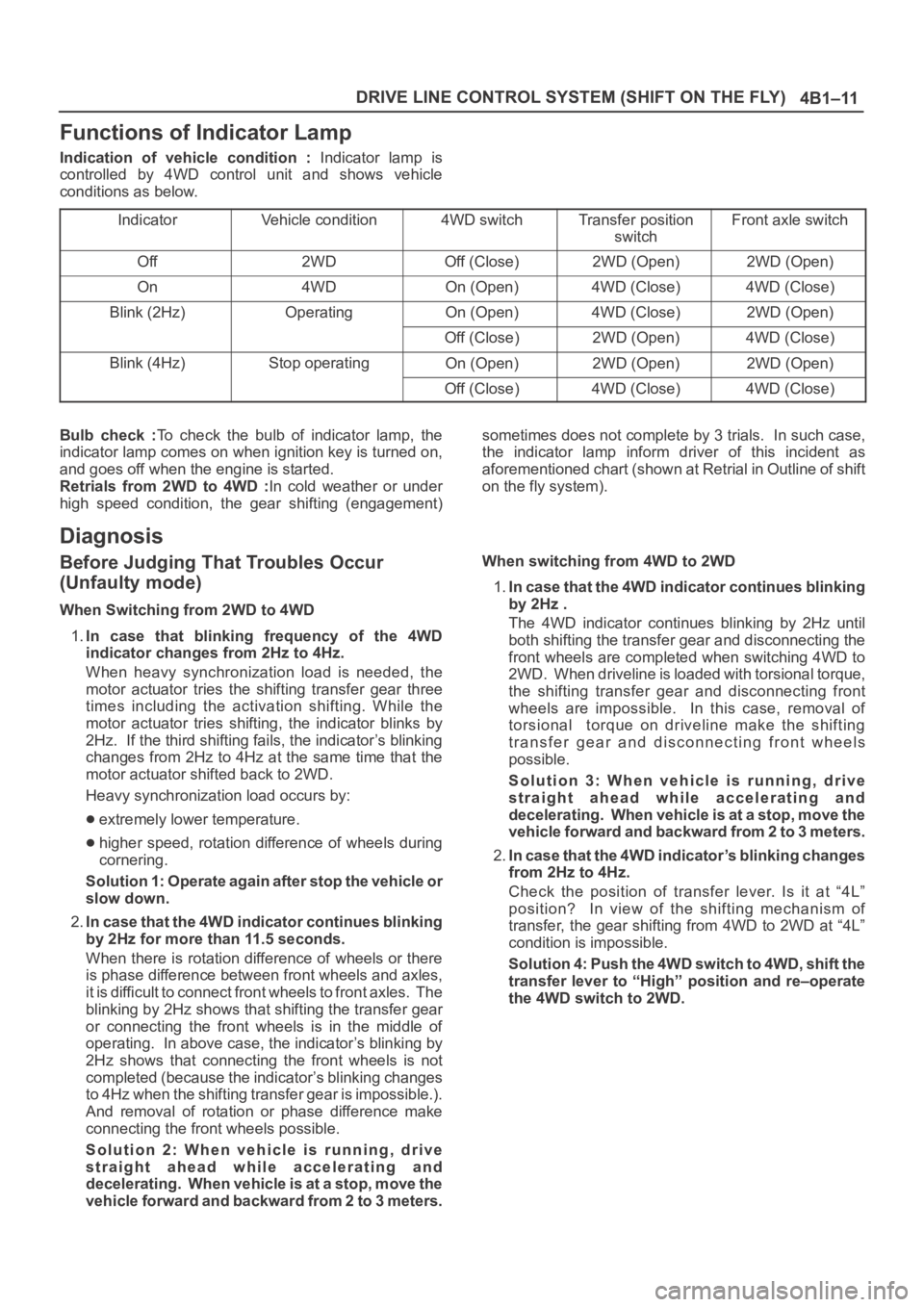
4B1–11 DRIVE LINE CONTROL SYSTEM (SHIFT ON THE FLY)
Functions of Indicator Lamp
Indication of vehicle condition : Indicator lamp is
controlled by 4WD control unit and shows vehicle
conditions as below.
Indicator
Vehicle condition4WD switchTransfer position
switchFront axle switch
Off2WDOff (Close)2WD (Open)2WD (Open)
On4WDOn (Open)4WD (Close)4WD (Close)
Blink (2Hz)OperatingOn (Open)4WD (Close)2WD (Open)
Off (Close)2WD (Open)4WD (Close)
Blink (4Hz)Stop operatingOn (Open)2WD (Open)2WD (Open)
Off (Close)4WD (Close)4WD (Close)
Bulb check :To check the bulb of indicator lamp, the
indicator lamp comes on when ignition key is turned on,
and goes off when the engine is started.
Retrials from 2WD to 4WD :In cold weather or under
high speed condition, the gear shifting (engagement)sometimes does not complete by 3 trials. In such case,
the indicator lamp inform driver of this incident as
aforementioned chart (shown at Retrial in Outline of shift
on the fly system).
Diagnosis
Before Judging That Troubles Occur
(Unfaulty mode)
When Switching from 2WD to 4WD
1.In case that blinking frequency of the 4WD
indicator changes from 2Hz to 4Hz.
When heavy synchronization load is needed, the
motor actuator tries the shifting transfer gear three
times including the activation shifting. While the
motor actuator tries shifting, the indicator blinks by
2Hz. If the third shifting fails, the indicator’s blinking
changes from 2Hz to 4Hz at the same time that the
motor actuator shifted back to 2WD.
Heavy synchronization load occurs by:
extremely lower temperature.
higher speed, rotation difference of wheels during
cornering.
Solution 1: Operate again after stop the vehicle or
slow down.
2.In case that the 4WD indicator continues blinking
by 2Hz for more than 11.5 seconds.
When there is rotation difference of wheels or there
is phase difference between front wheels and axles,
it is difficult to connect front wheels to front axles. The
blinking by 2Hz shows that shifting the transfer gear
or connecting the front wheels is in the middle of
operating. In above case, the indicator’s blinking by
2Hz shows that connecting the front wheels is not
completed (because the indicator’s blinking changes
to 4Hz when the shifting transfer gear is impossible.).
And removal of rotation or phase difference make
connecting the front wheels possible.
Solution 2: When vehicle is running, drive
straight ahead while accelerating and
decelerating. When vehicle is at a stop, move the
vehicle forward and backward from 2 to 3 meters.When switching from 4WD to 2WD
1.In case that the 4WD indicator continues blinking
by 2Hz .
The 4WD indicator continues blinking by 2Hz until
both shifting the transfer gear and disconnecting the
front wheels are completed when switching 4WD to
2WD. When driveline is loaded with torsional torque,
the shifting transfer gear and disconnecting front
wheels are impossible. In this case, removal of
torsional torque on driveline make the shifting
transfer gear and disconnecting front wheels
possible.
Solution 3: When vehicle is running, drive
straight ahead while accelerating and
decelerating. When vehicle is at a stop, move the
vehicle forward and backward from 2 to 3 meters.
2.In case that the 4WD indicator’s blinking changes
from 2Hz to 4Hz.
Check the position of transfer lever. Is it at “4L”
position? In view of the shifting mechanism of
transfer, the gear shifting from 4WD to 2WD at “4L”
condition is impossible.
Solution 4: Push the 4WD switch to 4WD, shift the
transfer lever to “High” position and re–operate
the 4WD switch to 2WD.